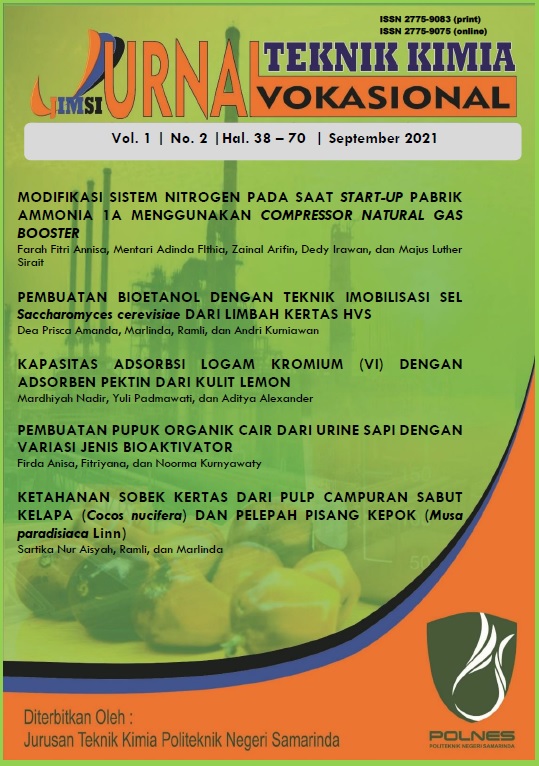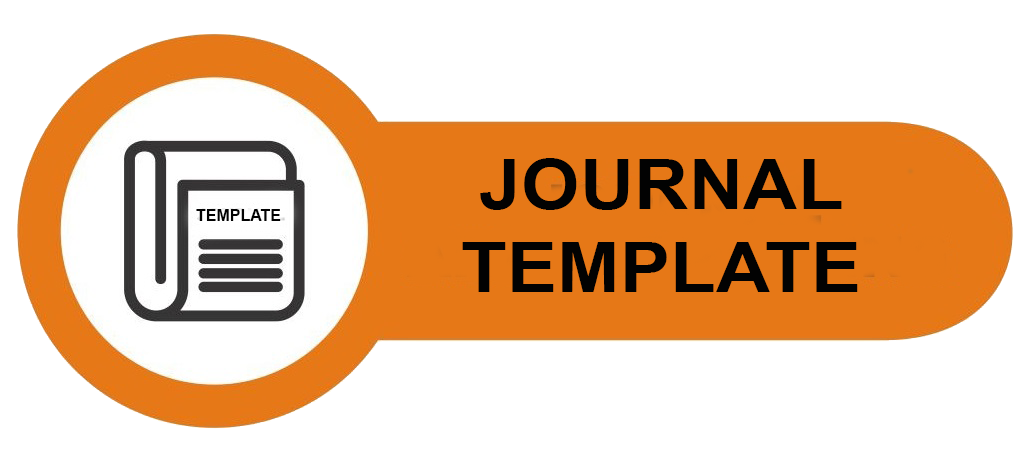PEMBUATAN BIOETANOL DENGAN TEKNIK IMOBILISASI SEL Saccharomyces cerevisiae DARI LIMBAH KERTAS HVS
 Abstract views: 657
,
Abstract views: 657
,
 pdf downloads: 522
pdf downloads: 522
Abstract
Produksi kertas di Indonesia berdasarkan Balai Besar Pulp dan Kertas (BBPK) mencapai 12,98 juta ton/tahun. Kertas yang telah digunakan dan dibuang dapat menimbulkan masalah bagi lingkungan. Kandungan selulosa pada kertas sangat tinggi sehingga dapat dimanfaatkan sebagai bahan baku bioetanol. Teknik fermentasi yang digunakan merupakan bioteknologi modern yaitu dengan metode imobilisasi sel. Metode ini menggunakan bahan inert yang tidak larut dalam substrat. Tujuan penelitian ini adalah untuk menentukan pengaruh konsentrasi imobilisasi sel Saccharomyces cerevisiae terhadap kadar bioetanol untuk meningkatkan kadar bioetanol yang dihasilkan. Kertas dihidrolisis dengan HCl 2N untuk memecah selulosa menjadi glukosa yang akan digunakan sebagai substrat. Variabel penelitian yang digunakan adalah konsentrasi imobilisasi sel Saccharomyces cerevisiae yaitu 0, 5, 10, 15, 20, dan 25% (b/b) dalam substrat. Fermentasi dilakukan dengan sistem batch selama 4 hari. Imobilisasi sel Saccharomyces cerevisiae dibuat menggunakan Na-Alginat 10% dan CaCl2 7%. Konsentrasi etanol dianalisa menggunakan gas kromatografi dan analisa jumlah sel menggunakan gravimetri. Hasil penelitian menunjukkan konsentrasi bioetanol maksimum pada konsentrasi imobilisasi sel 15%. Dimana konsentrasi bioetanol 8,1876% dan jumlah sel sebanyak 1,84 g sel/L.
Copyright (c) 2023 JURNAL TEKNIK KIMIA VOKASIONAL (JIMSI)

This work is licensed under a Creative Commons Attribution-NonCommercial-ShareAlike 4.0 International License.
Copyright Transfer Statement
The copyright of this article is transferred to JIMSI and when the article is accepted for publication. the authors transfer all and all rights into and to paper including but not limited to all copyrights in the Psikostudia. The author represents and warrants that the original is the original and that he/she is the author of this paper unless the material is clearly identified as the original source, with notification of the permission of the copyright owner if necessary. The author states that he has the authority and authority to make and carry out this task.
The author states that:
- This paper has not been published in the same form elsewhere.
- This will not be submitted elsewhere for publication prior to acceptance/rejection by this Journal.
A Copyright permission is obtained for material published elsewhere and who require permission for this reproduction. Furthermore, I / We hereby transfer the unlimited publication rights of the above paper to Jurnal Teknik Kimia Vokasional. Copyright transfer includes exclusive rights to reproduce and distribute articles, including reprints, translations, photographic reproductions, microforms, electronic forms (offline, online), or other similar reproductions.
The author's mark is appropriate for and accepts responsibility for releasing this material on behalf of any and all coauthor. This Agreement shall be signed by at least one author who has obtained the consent of the co-author (s) if applicable. After the submission of this agreement is signed by the author concerned, the amendment of the author or in the order of the author listed shall not be accepted.
Rights / Terms and Conditions Saved
- The author keeps all proprietary rights in every process, procedure, or article creation described in Work.
- The author may reproduce or permit others to reproduce the work or derivative works for the author's personal use or for the use of the company, provided that the source and the Informatika Mulawarman copyright notice are indicated, the copy is not used in any way implying the Jurnal Psikostudia approval of the product or service from any company, and the copy itself is not offered for sale.
- Although authors are permitted to reuse all or part of the Works in other works, this does not include granting third-party requests to reprint, republish, or other types of reuse.
Jurnal Teknik Kimia Vokasional by http://e-journal.polnes.ac.id/index.php/jimsi licensed under a Creative Commons Attribution-ShareAlike 4.0 International License.







